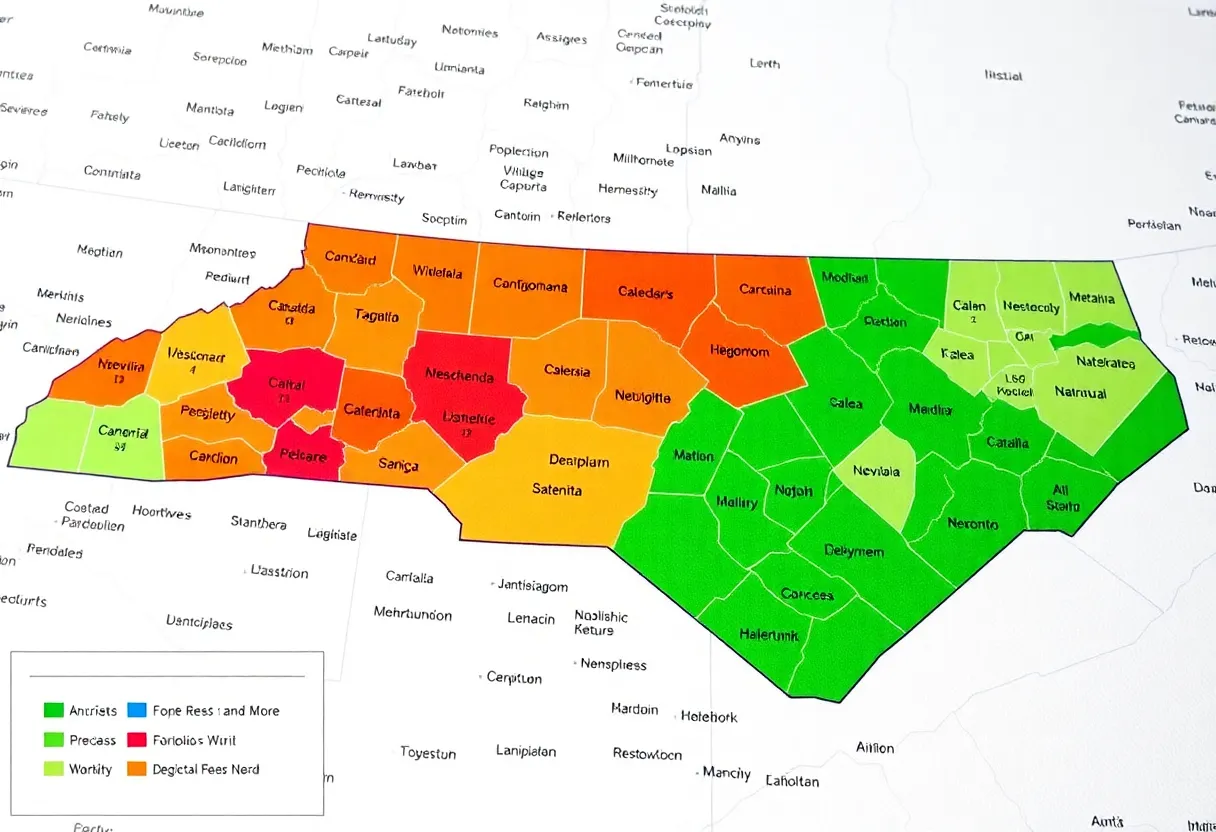North Carolina, October 15, 2025
A newly proposed congressional map in North Carolina may significantly impact the balance of power in U.S. Congress. Political analysts predict that the redrawn districts could favor Republicans, altering competitive districts and potentially changing the number of House seats. This shift raises questions about voter representation and the future of political dynamics within the state and nationally, making it a critical issue in upcoming elections.
Raleigh, North Carolina
North Carolina Republicans have announced plans to vote on redrawing the state’s U.S. House district map, aiming to secure an additional Republican seat ahead of the 2026 midterm elections. This move aligns with a nationwide redistricting effort by GOP-led states to strengthen their congressional representation.
In 2023, North Carolina Republicans implemented a congressional map that resulted in GOP candidates winning 10 of the state’s 14 U.S. House seats in 2024, compared to a 7-7 split between Democrats and Republicans under the previous map used in 2022. The proposed redistricting seeks to further solidify Republican control by targeting the 1st Congressional District, currently represented by Democrat Don Davis. Davis won re-election in 2024 by a narrow margin of less than 2 percentage points, indicating the district’s competitive nature. Adjusting the district’s boundaries could potentially favor a Republican candidate in future elections.
This initiative is part of a broader national strategy where Republican-led states, including Texas and Missouri, are revising congressional maps to gain additional seats. Critics argue that such actions constitute partisan gerrymandering, while proponents contend they are necessary to counteract Democratic redistricting efforts. In North Carolina, Democratic leaders and advocacy groups like the NAACP and Common Cause have expressed opposition, citing concerns over racial discrimination and voter dilution. The state’s Democratic governor does not have veto power over redistricting plans, allowing Republicans to proceed with their proposed changes.
The outcome of this redistricting effort could have significant implications for the balance of power in the U.S. House of Representatives, especially as both parties prepare for the upcoming midterm elections.
Frequently Asked Questions (FAQ)
What is the purpose of North Carolina’s proposed redistricting?
The proposed redistricting aims to redraw the state’s U.S. House district map to secure an additional Republican seat ahead of the 2026 midterm elections. This move is part of a broader national strategy by GOP-led states to strengthen their congressional representation.
Which congressional district is being targeted for redistricting?
The 1st Congressional District, currently represented by Democrat Don Davis, is the primary focus of the proposed redistricting. Davis won re-election in 2024 by a narrow margin of less than 2 percentage points, indicating the district’s competitive nature. Adjusting the district’s boundaries could potentially favor a Republican candidate in future elections.
What are the national implications of this redistricting effort?
This initiative is part of a broader national strategy where Republican-led states, including Texas and Missouri, are revising congressional maps to gain additional seats. Critics argue that such actions constitute partisan gerrymandering, while proponents contend they are necessary to counteract Democratic redistricting efforts. The outcome of this redistricting effort could have significant implications for the balance of power in the U.S. House of Representatives, especially as both parties prepare for the upcoming midterm elections.
What is the stance of North Carolina’s Democratic leaders on this redistricting?
Democratic leaders and advocacy groups in North Carolina, such as the NAACP and Common Cause, have expressed opposition to the proposed redistricting. They cite concerns over racial discrimination and voter dilution. Additionally, the state’s Democratic governor does not have veto power over redistricting plans, allowing Republicans to proceed with their proposed changes.
How does this redistricting compare to previous efforts in North Carolina?
In 2023, North Carolina Republicans implemented a congressional map that resulted in GOP candidates winning 10 of the state’s 14 U.S. House seats in 2024, compared to a 7-7 split between Democrats and Republicans under the previous map used in 2022. The proposed redistricting seeks to further solidify Republican control by targeting the 1st Congressional District, which is currently held by a Democrat.
What are the potential consequences of this redistricting for the 2026 midterm elections?
The proposed redistricting could have significant implications for the balance of power in the U.S. House of Representatives. By potentially adding another Republican-leaning district, the GOP aims to strengthen its position in the upcoming midterm elections. However, the effectiveness of this strategy will depend on various factors, including voter turnout and the political climate at the time of the elections.
Is there a possibility of legal challenges to this redistricting effort?
Yes, the proposed redistricting has faced opposition from Democratic leaders and advocacy groups, who have expressed concerns over racial discrimination and voter dilution. While the state’s Democratic governor does not have veto power over redistricting plans, legal challenges could still arise, particularly if opponents argue that the new map violates constitutional or voting rights protections.
How does this redistricting effort fit into the broader national context?
This redistricting effort in North Carolina is part of a broader national strategy where Republican-led states, including Texas and Missouri, are revising congressional maps to gain additional seats. These actions are in response to Democratic redistricting efforts, such as those in California, and are part of a larger political battle over control of the U.S. House of Representatives ahead of the 2026 midterm elections.
What is the timeline for implementing the proposed redistricting in North Carolina?
The Republican legislative leaders in North Carolina have announced plans to vote on the proposed redistricting next week. If approved, the new congressional map would be used in the 2026 midterm elections. The exact timeline for implementation will depend on the legislative process and any potential legal challenges that may arise.
How does this redistricting effort impact North Carolina’s current congressional delegation?
Currently, Republicans hold 10 of North Carolina’s 14 U.S. House seats, with the 1st Congressional District being the only competitive district. The proposed redistricting aims to adjust the boundaries of this district to favor a Republican candidate, potentially increasing the GOP’s representation in the state’s congressional delegation.
What are the potential reactions from voters to this redistricting effort?
Voter reactions to the proposed redistricting are likely to vary. Some may view it as a necessary step to ensure fair representation, while others may perceive it as a partisan maneuver. Public opinion will depend on individual perspectives and the perceived impact of the new map on their communities and political interests.
How does this redistricting effort compare to similar actions in other states?
Similar redistricting efforts are occurring in other states, such as Texas and Missouri, where Republican-led legislatures are revising congressional maps to gain additional seats. In contrast, California has proposed redistricting to favor Democrats. These actions reflect a broader national debate over the fairness and impact of redistricting practices on the balance of power in the U.S. House of Representatives.
What are the next steps in the redistricting process in North Carolina?
The next step is the scheduled vote by Republican legislative leaders on the proposed redistricting. If approved, the new congressional map would be implemented for the 2026 midterm elections. The process may also involve public hearings and potential legal challenges, which could influence the final outcome and timeline.
How does this redistricting effort affect North Carolina’s political landscape?
The proposed redistricting aims to strengthen Republican control in North Carolina by adjusting the boundaries of the 1st Congressional District to favor a Republican candidate. This could alter the state’s political landscape by increasing GOP representation in the U.S. House of Representatives, depending on the effectiveness of the new map and the political dynamics during the 2026 midterm elections.
What are the potential benefits and drawbacks of this redistricting effort?
Potential benefits include increased Republican representation in Congress and the ability to advance the party’s legislative agenda. Drawbacks may include perceptions of unfairness, potential legal challenges, and the impact on communities that may be affected by the redrawn district boundaries. Public opinion will play a significant role in determining the overall impact of this redistricting effort.
How does this redistricting effort align with national political trends?
This redistricting effort aligns with national political trends where both parties are seeking to redraw district boundaries to their advantage ahead of the 2026 midterm elections. Republican-led states are revising maps to gain additional seats, while Democratic-led states are pursuing similar strategies to maintain or increase their representation in Congress.
What is the role of the governor in North Carolina’s redistricting process?
In North Carolina, the governor does not have veto power over redistricting plans. This allows the Republican-led legislature to proceed with their proposed changes without gubernatorial approval. However, the governor can still influence the process through public statements and by supporting or opposing legal challenges to the new map.
How does this redistricting effort impact minority communities in North Carolina?
Critics of the proposed redistricting, including advocacy groups like the NAACP and Common Cause, have expressed concerns that the new map could dilute the voting power of minority communities. These groups argue that the redistricting may lead to racial discrimination and voter dilution, potentially affecting the ability of minority voters to elect their preferred candidates.
What are the potential legal challenges to this redistricting effort?
Potential legal challenges could arise if opponents argue that the new map violates constitutional or voting rights protections. Advocacy groups and Democratic leaders have expressed concerns over racial discrimination and voter dilution, which could form the basis for legal action against the proposed redistricting.
How does this redistricting effort affect the balance of power in Congress?
The proposed redistricting aims to increase Republican representation in Congress by adjusting the boundaries of the 1st Congressional District to favor a Republican candidate. If successful, this could shift the balance of power in the U.S. House of Representatives, especially if the GOP gains additional seats in the 2026 midterm elections.
What are the next steps in the redistricting process in North Carolina?
The next step is the scheduled vote by Republican legislative leaders on the proposed redistricting. If approved, the new congressional map would be implemented for the 2026 midterm elections. The process may also involve public hearings and potential legal challenges, which could influence the final outcome and timeline.
How does this redistricting effort affect North Carolina’s political landscape?
The proposed redistricting aims to strengthen Republican control in North Carolina by adjusting the boundaries of the 1st Congressional District to favor a Republican candidate. This could alter the state’s political landscape by increasing GOP representation in the U.S. House of Representatives, depending on the effectiveness of the new map and the political dynamics during the 2026 midterm elections.
What are the potential benefits and drawbacks of this redistricting effort?
Potential benefits include increased Republican representation in Congress and the ability to advance the party’s legislative agenda. Drawbacks may include perceptions of unfairness, potential legal challenges, and the impact on communities that may be affected by the redrawn district boundaries. Public opinion will play a significant role in determining the overall impact of this redistricting effort.
How does this redistricting effort align with national political trends?
This redistricting effort aligns with national political trends where both parties are seeking to redraw district boundaries to their advantage ahead of the 2026 midterm elections. Republican-led states are revising maps to gain additional seats, while Democratic-led states are pursuing similar strategies to maintain or increase their representation in Congress.
What is the role of the governor in North Carolina’s redistricting process?
In North Carolina, the governor does not have veto power over redistricting plans. This allows the Republican-led legislature to proceed with their proposed changes without gubernatorial approval. However, the governor can still influence the process through public statements and by supporting or opposing legal challenges to the new map.
How does this redistricting effort impact minority communities in North Carolina?
Critics of the proposed redistricting, including advocacy groups like the NAACP and Common Cause, have expressed concerns that the new map could dilute the voting power of minority communities. These groups argue that the redistricting may lead to racial discrimination and voter dilution, potentially affecting the ability of minority voters to elect their preferred candidates.
What are the potential legal challenges to this redistricting effort?
Potential legal challenges could arise if opponents argue that the new map violates constitutional or voting rights protections. Advocacy groups and Democratic leaders have expressed concerns over racial discrimination and voter dilution, which could form the basis for legal action against the proposed redistricting.
Deeper Dive: News & Info About This Topic
HERE Resources
North Carolina to Debate Congressional Map Redistricting
Author: Construction NC News
NORTH CAROLINA STAFF WRITER The NORTH CAROLINA STAFF WRITER represents the experienced team at constructionncnews.com, your go-to source for actionable local news and information in North Carolina and beyond. Specializing in "news you can use," we cover essential topics like product reviews for personal and business needs, local business directories, politics, real estate trends, neighborhood insights, and state news affecting the area—with deep expertise drawn from years of dedicated reporting and strong community input, including local press releases and business updates. We deliver top reporting on high-value events such as the North Carolina Build Expo, major infrastructure projects, and advancements in construction technology showcases. Our coverage extends to key organizations like the Associated Builders and Contractors of the Carolinas and the North Carolina Home Builders Association, plus leading businesses in construction and legal services that power the local economy such as CMiC Global and Womble Bond Dickinson LLP. As part of the broader network, including constructioncanews.com, constructionnynews.com, and constructiontxnews.com, we provide comprehensive, credible insights into the dynamic construction landscape across multiple states.





